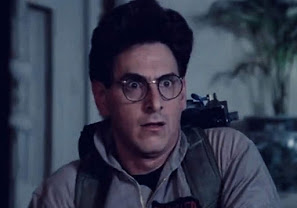Pick of the Brown Bag
November 19, 2021
by
Ray Tate
SPOILER FREE ZONE
Ghostbusters: Afterlife is a direct sequel to the first Ghostbusters film. The oft neglected Ghostbusters II, which I have a certain fondness for, tackled a new spectral problem.
Afterlife goes back to the structure of the original's plot to find its menace. It furthermore serves as a genuine loving tribute to the late Harold Ramis.
Afterlife cleverly answers the questions why now, why here and who are you going to call? After a startling, scary prologue, the film properly begins as a light, contemporary drama about single mom Callie being forced to move out of her home to an old farm she inherits. The farm isn't exactly a boon and exemplifies the word ramshackle quite nicely.
Callie is kind of a mess, and not the typical mom. Callie's daughter Phoebe is a genius.
Her son Trevor not so much. At least not the scientific kind. Trevor exhibits manual dexterity and automotive skills that far surpass his age.
All of them bear an authenticity that belies the genre they're operating in. You could meet these people in a very good indie film that has nothing to do with spooky encounters.
The town to which they move used to be an old mining town, and it is here where the supernatural activity starts to muster. The pacing of Afterlife grants a lot of room for the characters to breathe and grow. The filmmakers make the wise choice of hinting at eerie things and a seething cauldron about to boil. This isn't a spectacle film. It builds its threat before releasing the true stakes in the final act.
Phoebe, along with her new friend Podcast, and ally, teacher Mr. Grooberson begin to discover strange-goings on. Mr. Grooberson in fact has been tracking a curiosity that interests Phoebe and allows them to bond over science.
The conclusion unnatural coincides with the discovery of Ghostbusters equipment. It's not a coincidence or contrivance. There's a good reason for this equipment being in the town. The discovery directed. Phoebe, Podcast, her brother Trevor and another soon find themselves forced to become a next generation of Ghostbusters.
Though the original cast lends their talent to the movie, the story centers on the younger casts' becoming. The formation of this new team is awash with genuine sweet moments, subtle comedy and relationships that lack a hint of saccharine. The love story can be found in the brother, sister and mother which holds the tale together. The like stories between other cast members form quite naturally and believably. What's more. Nobody in the supporting cast exhibits venom. They're all either nice, normal and/or credulous. A refreshing change.
In technical terms, the filmmakers wisely went back to the basics of Ghostbusters. While some if not all the ghostly figures are computer graphics, they nevertheless echo the skillful charm of the original creatures. The cast is uniformly extraordinary and McKenna Grace who portrays Phoebe is the riveting star.
SPOILER FREE ZONE ENDS
No, you know what, no spoilers. Go see the movie.







































